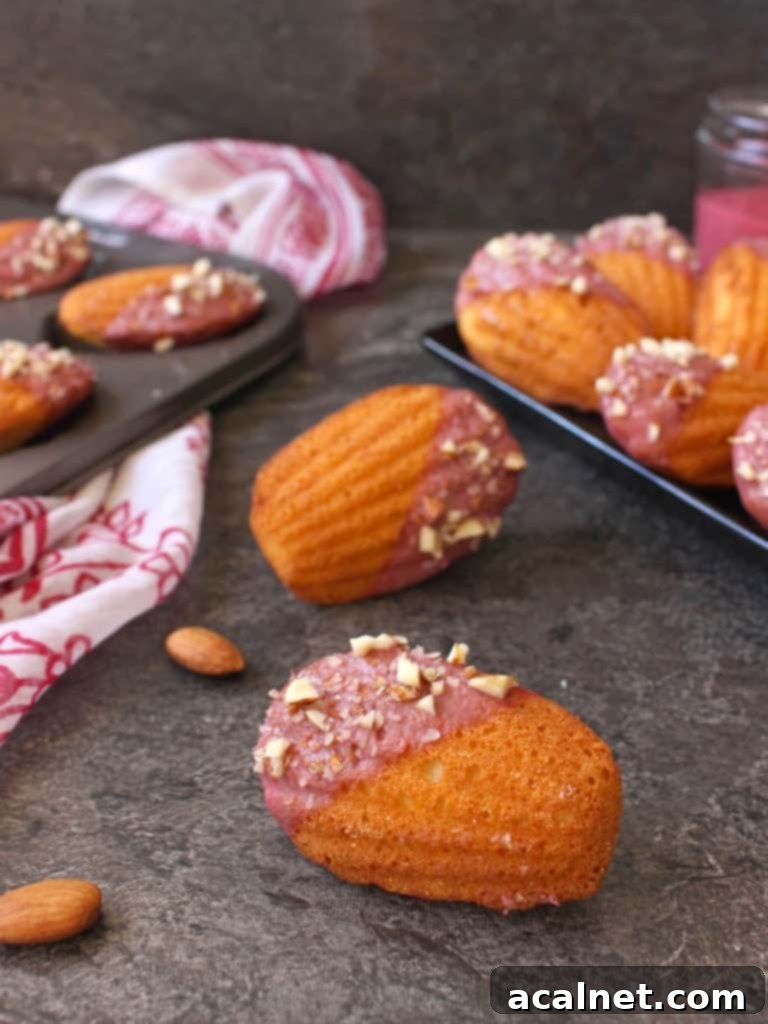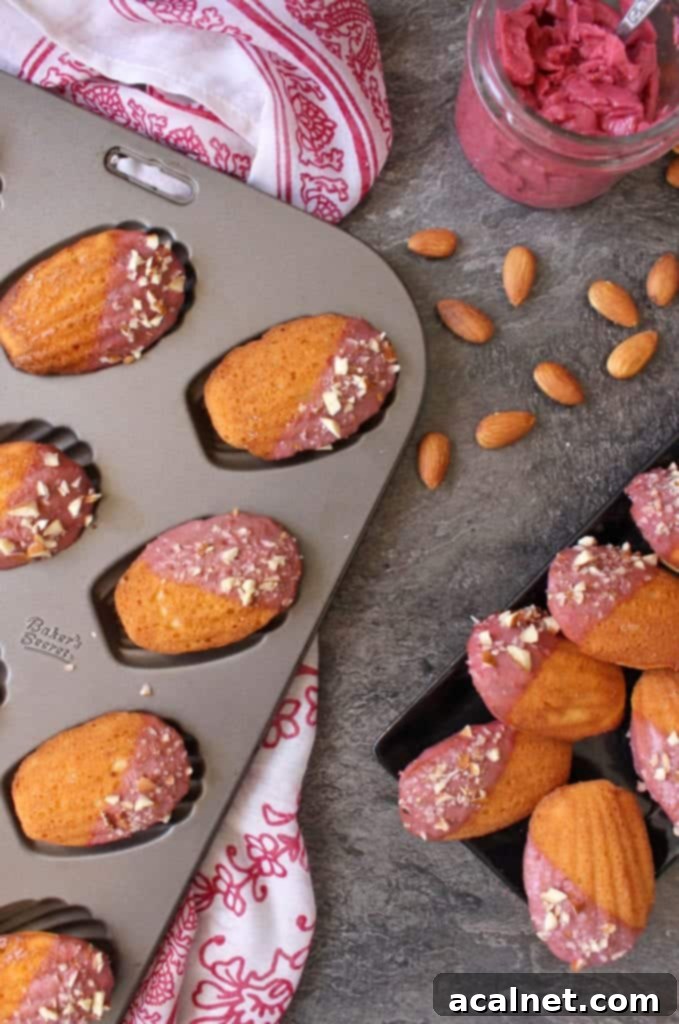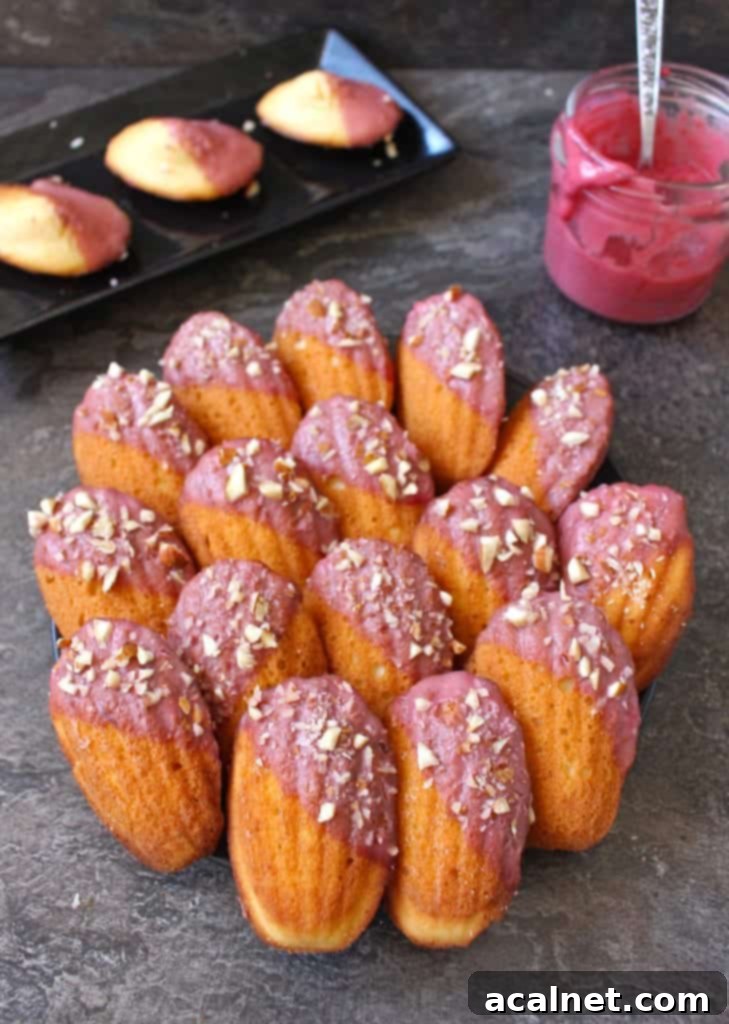Raspberry Almond Madeleines: The Ultimate Guide to Perfectly Glazed French Shell Cakes
Indulge in the delicate charm of these **Raspberry Almond Madeleines**, a truly exquisite sweet treat perfect for elevating your morning coffee or afternoon tea. Crafted with a light and fluffy almond flour batter, these traditional French Madeleines are wonderfully moist and melt-in-your-mouth. Each golden shell cake is elegantly finished with a vibrant, tangy raspberry glaze, adding a beautiful pop of color and a burst of fresh fruit flavor that perfectly complements the nutty almond base.

Jump to Recipe Card
Why You’ll Fall in Love with This Raspberry Almond Madeleine Recipe
Madeleines hold a special place in French culinary tradition, beloved for their unique shell shape and delicate texture. There’s nothing quite like biting into a freshly baked Madeleine—it’s a world apart from the often dry, store-bought versions. The first taste of a warm, tender Madeleine, straight from the oven, is truly unforgettable. Years ago, I became utterly captivated by the art of making Madeleines, experimenting with countless recipes and flavor combinations, from classic vanilla to rich Chocolate Madeleines. This particular recipe for Raspberry Almond Madeleines stands out, offering a delightful twist on the classic.
This recipe combines the classic appeal of Madeleines with the rich, nutty flavor of almonds and the bright, tart notes of fresh raspberries. The almond meal contributes to an incredibly moist crumb, while the raspberry glaze adds a refreshing tang and a visually stunning finish. These aren’t just cakes; they’re tiny masterpieces, perfect for impressing guests or simply treating yourself to a moment of pure bliss. They vanish quickly, testament to their irresistible taste and texture!
What Exactly Are Madeleines? A French Pastry Explained
For those unfamiliar, Madeleines are small, shell-shaped sponge cakes, originating from the Lorraine region of France. They are instantly recognizable by their distinctive scallop shape on one side and the characteristic “hump” or “belly” on the other. This unique form is achieved by baking them in a special fluted Madeleine pan, designed to create these charming characteristics.
The magic of a Madeleine lies in its batter, which is traditionally a Genoise cake batter. Genoise is a light sponge cake renowned for its airy texture, achieved by whisking eggs and sugar together until they become incredibly light, pale, and significantly increased in volume. This process incorporates a substantial amount of air, which is crucial for the Madeleine’s signature lightness and fluffy texture. Unlike many cakes that rely heavily on chemical leaveners, the Genoise method emphasizes mechanical aeration, making the preparation a delicate dance of technique and temperature.
The literary world also celebrates Madeleines, most famously in Marcel Proust’s “In Search of Lost Time” (À la recherche du temps perdu), where the taste of a Madeleine dipped in tea triggers a flood of involuntary memories. This cultural significance only adds to the allure of these exquisite little cakes, making them a symbol of nostalgia and comfort.

Essential Ingredients for Classic Madeleines
While there are countless Madeleine recipes, they all typically share a core set of fundamental ingredients. Understanding the role each plays is key to mastering these delicate French cakes:
- Eggs: The backbone of a Genoise batter. When whisked with sugar, they create the airy, stable foam that gives Madeleines their light texture and helps them rise.
- Sugar: Not only sweetens but also helps stabilize the egg foam and contributes to the golden-brown crust. Caster sugar (superfine sugar) is often preferred for its ability to dissolve quickly and evenly.
- Butter: Adds richness, moisture, and flavor. Melted butter is carefully folded into the aerated egg mixture, providing a tender crumb.
- Flour: Provides structure to the cake. Plain (all-purpose) flour is common, but in this recipe, we introduce almond meal for an enhanced texture.
- Baking Powder: While much of the lift comes from the eggs, a touch of baking powder ensures an even better rise and that coveted “hump.”
- Salt: A pinch of salt balances the sweetness and enhances all the other flavors, making them more pronounced.
Beyond these basics, you can personalize your Madeleines with various flavorings. Many traditional recipes include a hint of lemon zest or vanilla extract. You could even venture into savory territory, perhaps with herbs and cheese, creating a delightful appetizer!
Crucially, to achieve the iconic shell shape, a dedicated **Madeleine pan** is indispensable. The most common type features small, elongated shell molds. I often recommend a metal pan, which conducts heat efficiently for that perfect golden crust and prominent hump. However, silicone Madeleine pans are also a convenient alternative, offering easy release and cleaning, and taking up less storage space. For a whimsical touch, round shell pans are also available, allowing for creative variations.

The Magic of Almond Meal in Madeleines
For this particular recipe, we take the classic Madeleine and elevate it by substituting a portion of the plain flour with **Ground Almonds, or Almond Meal**. This intentional choice significantly enhances the Madeleine batter, making it even lighter, fluffier, and exceptionally moist. If you’ve been a long-time reader, you’ve likely heard me sing praises about almond meal before, particularly for its ability to create super moist cakes. And I’ll gladly reiterate: Almond Meal is truly fantastic for adding moisture and a delicate texture to baked goods. It also serves as a wonderful gluten-free alternative to wheat flour, opening up new possibilities for those with dietary restrictions.
Incorporating almond meal into Madeleines imparts a subtle, sweet nuttiness that pairs beautifully with the tangy raspberry glaze. It contributes to a tender, almost melt-in-your-mouth crumb that is distinctly different from traditional flour-only Madeleines. This blend of flours creates a more sophisticated flavor profile and a superior texture that will make these Madeleines truly unforgettable. If you’re curious about almond meal’s versatility, I highly recommend trying this amazing Pear and Almond Cake.
Aside from the addition of almond meal, the rest of the Madeleine preparation adheres to classic methods. You’ll need the following key ingredients to create the delicate batter (refer to the recipe card below for exact quantities):
- Caster Sugar
- Eggs
- Melted Butter
- Plain Flour
- Almond Meal (for that extra tenderness and flavor)
- Baking Powder
- Salt
- Lemon Juice and Zest (optional, but highly recommended for brightness)
While the lemon is optional, its bright acidity really accentuates the flavors of the other ingredients and adds a refreshing counterpoint to the richness of the butter and almonds. It’s a small detail that makes a big difference in the overall taste.

Achieving the Perfect Hump: Tips for Making Almond Flour Madeleines
Baking Madeleines, especially with almond flour, involves a few crucial techniques that ensure their signature “hump” and delicate texture. Mastering these steps will lead to beautifully risen, light, and tender shell cakes:
- Whisking Eggs and Sugar to Perfection: This is arguably the most critical step. You need to whisk the sugar and eggs together vigorously until they are very pale, thick, and have at least doubled, if not tripled, in volume. This is often referred to as reaching the “ribbon stage” – when you lift the whisk, the batter should fall back into the bowl in a thick ribbon that holds its shape on the surface for a few seconds before disappearing. This extensive whisking incorporates a significant amount of air, which is essential for the Madeleines’ light structure and proper rise. If not whisked enough, your Madeleines will be dense and won’t develop their iconic hump.
- Temperature Matters: Room Temperature Ingredients: Always start with room temperature eggs and butter. Room temperature ingredients emulsify more easily, creating a smoother, more uniform batter that traps air efficiently. Cold ingredients can cause the batter to seize or become lumpy.
- Chilling the Batter: The Secret to the Hump: After mixing, the Madeleine batter must be chilled in the fridge for at least 15 to 20 minutes, or even longer (up to several hours or overnight for best results). This chilling period is vital for several reasons. Firstly, it allows the flour to fully hydrate, resulting in a more tender crumb. Secondly, and most importantly, it creates a thermal shock when the cold batter hits the hot oven. The outside of the Madeleine sets quickly, while the center continues to expand, forcing that characteristic hump upwards.
- Pre-heating and Oven Temperature Management: You want to preheat your oven to a relatively high temperature (around 230°C / 450°F). However, as soon as you place your chilled Madeleines into the oven, immediately reduce the temperature to a lower setting (around 170°C / 340°F). This initial blast of high heat provides the necessary thermal shock for the hump, while the subsequent lower temperature allows the Madeleines to bake through evenly without burning. Consistency in oven temperature is key, so make sure your oven is accurately calibrated.
- Preparing the Madeleine Pan: A well-greased and floured Madeleine pan (or lightly oiled if using a non-stick spray) is essential to prevent sticking and ensure those beautifully defined shell patterns. For extra crispiness and flavor, some bakers even “butter and flour” their pans, then chill them before filling.
By paying close attention to these details, you’ll be well on your way to baking Madeleines that are not only delicious but also visually perfect, with that quintessential golden brown edge and a proud little hump.
Crafting the Perfect Raspberry Glaze
The **Raspberry Glaze** is more than just a topping; it’s a critical element that elevates these Madeleines, providing a burst of refreshing fruitiness and a stunning visual appeal. Its vibrant color makes the Madeleines truly pop, and its sharp, tangy flavor perfectly balances the sweet, nutty almond cakes.
Making this glaze is surprisingly straightforward. Here’s how it comes together:
- Making the Raspberry Puree: You’ll start by simmering frozen raspberries with water, lemon juice, cinnamon powder, and a touch of caster sugar. Frozen raspberries are ideal as they break down easily and release their juices, creating a concentrated flavor. Reduce this mixture into a thick puree, allowing the flavors to meld beautifully.
- Blending for Smoothness: After a brief cooling period, transfer the raspberry puree to a blender. This is where the magic happens: add **Coconut Cream**. The coconut cream adds a lovely richness and creamy texture to the glaze, creating a beautifully smooth consistency when blended with the fruit.
- Straining for a Silky Finish: To ensure your glaze is perfectly smooth and free of any seeds, pass the blended liquid through a fine-mesh sieve. This step is crucial for achieving that professional, glossy finish.
- Thickening with Agar Agar: Pour the strained liquid back into the pot and bring it to a boil. The star ingredient here is Agar Agar Powder. Agar agar is a plant-based gelatin alternative that provides excellent gelling properties. Unlike gelatin, it’s suitable for vegetarians and vegans, and it sets firmly at room temperature. Add the agar agar powder to the boiling liquid and whisk constantly for about two minutes until it begins to thicken. This ensures the glaze will set beautifully on your Madeleines, providing a clean, non-sticky finish.
- Glazing Immediately: As soon as the glaze is ready and slightly thickened, remove it from the heat and begin dipping your cooled Madeleines. It’s important to work relatively quickly, as agar agar sets as it cools. Dip each Madeleine, allowing excess glaze to drip off, and then sprinkle with finely chopped almonds for an added textural crunch and nutty flavor.
Allow the glazed Madeleines to set for at least 20 minutes before serving. This allows the glaze to firm up, creating a beautiful, protective coating that seals in moisture and adds to the aesthetic appeal. The result is a vibrant, flavorful, and perfectly textured Madeleine that is a delight to behold and taste.

Storage and Serving Suggestions for Your Raspberry Almond Madeleines
How to Store Madeleines
For optimal freshness and flavor, Madeleines are best enjoyed the day they are baked. However, if you have leftovers, store them in an airtight container at room temperature for up to 2-3 days. The glaze will help preserve their moisture slightly. To refresh them, you can gently warm them in a microwave for 5-10 seconds or in a low oven for a few minutes; this will bring back some of their delicate texture.
Perfect Serving Ideas
These Raspberry Almond Madeleines are incredibly versatile for serving. Here are a few ideas:
- Classic Tea Time: Serve them alongside a warm cup of Earl Grey, green tea, or herbal infusion. The delicate flavors complement each other beautifully.
- Coffee Break Delight: A perfect accompaniment to your morning or afternoon coffee. The sweetness and tang are a lovely contrast to the coffee’s robust flavor.
- Elegant Dessert: Arrange them on a platter for a sophisticated dessert. They can be served simply as they are, or with a side of fresh berries or a dollop of whipped cream.
- Gift Giving: Package a few Madeleines in a pretty box with a ribbon. They make a thoughtful and delicious homemade gift for friends and family.
More Tea Time Snack Ideas
If you’re looking for more delightful treats to accompany your tea or coffee, explore these other fantastic recipes:
- Chocolate Caramel Slices
- Chocolate Brownie Bites
- Almond Flour Peanut Butter Cookies
- Lemon and Raspberry Muffins
- Double Chocolate Scones
- Financiers Cakes
Made this recipe?
Let us know if you liked it by leaving a comment below, and tag us on Instagram @a.baking.journey with a photo of your creation!
Recipe Card: Raspberry Almond Madeleines with Glaze

Almond Madeleines with Raspberry Glaze
Print Recipe
Ingredients
Almond Madeleines
- 1/3 cup (100 gr) Melted Butter
- 1/4 cup (50 gr) Caster Sugar
- 3 Eggs
- 1/2 Lemon: Juice + Zest
- 1 cup (100 gr) Almond Meal
- 2/3 cups (110 gr) Plain Flour
- 1 teaspoon Baking Powder
- 1 pinch Salt
Raspberry Glaze
- 1 cup (100gr) Frozen Raspberries
- 1/2 cup (120ml) Water
- 2 tbsp Lemon Juice
- 1/2 teaspoon Cinnamon Powder
- 1 tbsp. Caster Sugar
- 1/2 cup (120ml) Coconut Cream
- 1/2 teaspoon Agar Agar Powder
Garnish
- 2 Dozen Raw Almonds
Instructions
Almond Madeleines
- Melt the butter in a small bowl and set aside to cool down.
- In a large mixing bowl, whisk the Sugar and Eggs for a few of minutes until it has doubled in size and foamy. Pour in the cooled melted Butter and stir well.
- Fold in the Almond Meal, Lemon Zest and Lemon Juice.
- In a separate bowl, combine the Flour, Baking Powder and Salt. Sift it in the batter, and once completely incorporated, place in the fridge to chill for about 15 minutes.
- Turn on the oven on 230’C.
While the oven is heating up, spray your Madeleine Pan with Canola Oil or rub a little bit of butter in.
- Pour about a tablespoon of batter in each shell. They should be about 2/3 filled.
When hot, put the Madeleines in the oven and directly reduce the temperature to 170’. Bake to 8 to 10 minutes. Transfer onto a cooling rack.
Raspberry Glaze
- Once the Madeleines have completely cooled down, start preparing the Raspberry Glaze. Put the Water, Frozen Raspberries, Lemon Juice, Cinnamon Powder and Caster Sugar in a pot, bring to a boil and let reduce into a Puree for about 10 minutes.
- Set aside to cool down for 5 minutes, then transfer the Raspberry Puree in the Blender. Add the Coconut Cream and blend until completely smooth.
- Pass the liquid through a sieve to remove all the seeds then pour it back into the pot. Bring to a boil.
- Once the liquid is boiling, add the Agar Agar Powder. Leave on the heat for about 2 minutes – constantly whisking – until the liquid starts thickening. Remove from the heat.
- Dip your Madeleines in the Raspberry Glaze and sprinkle with finely chopped Almonds. Let the Madeleines set for at least 20 minutes.
Would you like to save this recipe?
We’ll email this post to you, so you can come back to it later!
Notes
Nutrition (per serving)
